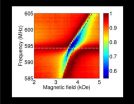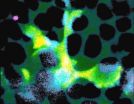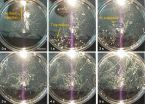The proteasome complex is present in all multicellular organisms, and plays a critical role in cancer by allowing cancer cells to divide rapidly.
Researchers used a technique called electron cryo-microscopy, or 'cryo-EM' - imaging samples frozen to -180oC - to show the proteasome complex in such extraordinary detail that they could view a prototype drug bound to its active sites.
The results could help improve scientists' ability to build molecules that interlock very specifically with target sites on proteins - a fundamental part of designing new anti-cancer drugs.
Scientists from The Institute of Cancer Research, London, and the Medical Research Council (MRC) Laboratory of Molecular Biology in Cambridge were able to visualise the proteasome complex down to a resolution of around 3.5 Angstroms, or 3.5 ten-billionths of a metre.
The study is published today (Thursday) in Nature Communications and was funded by Cancer Research UK and the MRC.
The research could help other scientists to use cryo-EM in structure-based drug design studies - in which researchers build the best possible drugs starting from a molecule which already binds to the active site of a target protein.
Until recently such studies were generally only possible using X-ray crystallography, but researchers have been unable to crystallise many protein complexes in order to study them using that technique.
The proteasome plays a key role in the smooth running of a healthy cell, facilitating cell renewal and death - chopping up proteins tagged for destruction into short polypeptides which can then be converted to amino-acids and recycled for use in building new proteins.
It plays an important role in cell division, which is controlled by the synchronised destruction of regulatory proteins. Blocking the proteasome prevents this regulated recycling of amino acids and triggers controlled cell death, particularly in fast-dividing cells typical of cancer. Some cancer drugs have already been developed to target it.
Images produced by the study clearly show the structure of the proteasome complex - with the protein backbone of each of its 28 subunits visible along with most of the side chains of the proteins.
An inhibitor molecule used by the researchers was shown to be visibly bound at each of its three target sites on the proteasome.
Electron cryo-microscopy is emerging as a complementary approach in cancer drug design to X-ray crystallography - which involves generating highly ordered crystals of proteins and hitting them with X-ray radiation.
Cryo-EM offers the opportunity to study protein complexes in conditions closer to those in the human body.
In this experiment, researchers rapidly froze samples of the proteasome bound to the inhibitor to allow them to be examined in the electron microscope at -180oC. They bombarded their samples with electrons and generated images using complex image-processing software.
Senior study author Dr Edward Morris, Team Leader in Structural Electron Microscopy at The Institute of Cancer Research, London, said:
"Our study zooms in to display the proteasome complex - a recycling unit which plays a critical role in our cells - in far greater detail than we have ever seen before in the electron microscope. By imaging the protein at ultra-low temperatures, we were able to clearly show the target site for potential cancer drugs - and could even show an inhibitor bound in place, and blocking the proteasome's action.
"By imaging how proteins interlock in ultra-fine detail, down to the tens of billionths of a metre, our study should make it much easier to design new, more potent cancer drugs. Previously such studies could only be achieved by X-ray crystallography, but using the electron microscope will allow us to tackle protein complexes which no one has been able to crystallise, and to do this under conditions which are much closer to those in the human body."
Dr Emma Smith, senior science communications officer at Cancer Research UK, said: "Revealing the molecule's detailed shape could be the first step towards designing more precise drugs to block it. This molecule plays an important role in some cancers and drugs that block it are already available to patients - but making drugs that are more effective and less damaging to healthy cells could lead to patients living longer and reduce side effects."
INFORMATION:
Notes to editors
For more information contact Henry French on 020 7153 5582 or henry.french@icr.ac.uk. For enquiries out of hours, please call 07595 963 613.
The Institute of Cancer Research, London, is one of the world's most influential cancer research institutes.
Scientists and clinicians at The Institute of Cancer Research (ICR) are working every day to make a real impact on cancer patients' lives. Through its unique partnership with The Royal Marsden NHS Foundation Trust and 'bench-to-bedside' approach, the ICR is able to create and deliver results in a way that other institutions cannot. Together the two organisations are rated in the top four cancer centres globally.
The ICR has an outstanding record of achievement dating back more than 100 years. It provided the first convincing evidence that DNA damage is the basic cause of cancer, laying the foundation for the now universally accepted idea that cancer is a genetic disease. Today it leads the world at isolating cancer-related genes and discovering new targeted drugs for personalised cancer treatment.
As a college of the University of London, the ICR provides postgraduate higher education of international distinction. It has charitable status and relies on support from partner organisations, charities and the general public.
The ICR's mission is to make the discoveries that defeat cancer. For more information visit http://www.icr.ac.uk
About Cancer Research UK
Cancer Research UK is the world's leading cancer charity dedicated to saving lives through research.
Cancer Research UK's pioneering work into the prevention, diagnosis and treatment of cancer has helped save millions of lives.
Cancer Research UK receives no government funding for its life-saving research. Every step it makes towards beating cancer relies on every pound donated.
Cancer Research UK has been at the heart of the progress that has already seen survival rates in the UK double in the last forty years.
Today, 2 in 4 people survive cancer. Cancer Research UK's ambition is to accelerate progress so that 3 in 4 people will survive cancer within the next 20 years.
Cancer Research UK supports research into all aspects of cancer through the work of over 4,000 scientists, doctors and nurses.
Together with its partners and supporters, Cancer Research UK's vision is to bring forward the day when all cancers are cured.
For further information about Cancer Research UK's work or to find out how to support the charity, please call 0300 123 1022 or visit http://www.cancerresearchuk.org. Follow us on Twitter and Facebook.
The Medical Research Council has been at the forefront of scientific discovery to improve human health. Founded in 1913 to tackle tuberculosis, the MRC now invests taxpayers' money in some of the best medical research in the world across every area of health. Twenty-nine MRC-funded researchers have won Nobel prizes in a wide range of disciplines, and MRC scientists have been behind such diverse discoveries as vitamins, the structure of DNA and the link between smoking and cancer, as well as achievements such as pioneering the use of randomised controlled trials, the invention of MRI scanning, and the development of a group of antibodies used in the making of some of the most successful drugs ever developed. Today, MRC-funded scientists tackle some of the greatest health problems facing humanity in the 21st century, from the rising tide of chronic diseases associated with ageing to the threats posed by rapidly mutating micro-organisms. http://www.mrc.ac.uk



